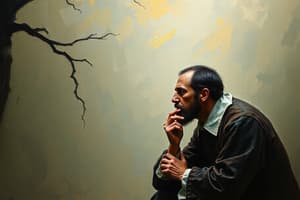Podcast
Questions and Answers
What modern element is present in the set and costuming of Hamlet?
What modern element is present in the set and costuming of Hamlet?
- Militaristic feel (correct)
- Renaissance style
- Post-apocalyptic design
- Victorian fashion
How do the themes in Shakespeare's plays relate to contemporary society?
How do the themes in Shakespeare's plays relate to contemporary society?
- They primarily reflect historical conflicts.
- They lack relevance to modern issues.
- They resonate with 21st-century analogues. (correct)
- They only focus on medieval moralities.
What personal tragedies influenced the writing of Hamlet?
What personal tragedies influenced the writing of Hamlet?
- The loss of a close friend
- The loss of a patron
- A failed romantic relationship
- The deaths of Shakespeare's son and father (correct)
Which theme is prominently featured in Hamlet alongside madness?
Which theme is prominently featured in Hamlet alongside madness?
What theme is highlighted through Hamlet's antics and the pressure on Rosencrantz and Guildenstern?
What theme is highlighted through Hamlet's antics and the pressure on Rosencrantz and Guildenstern?
How does the scene with the players reenacting King Hamlet's death affect Claudius?
How does the scene with the players reenacting King Hamlet's death affect Claudius?
What effect does the militaristic setting have on the interpretation of Hamlet?
What effect does the militaristic setting have on the interpretation of Hamlet?
Which of the following reflects a dimension of madness in Hamlet?
Which of the following reflects a dimension of madness in Hamlet?
What does Hamlet plan to do with The Mousetrap?
What does Hamlet plan to do with The Mousetrap?
How do the symbols in Hamlet contribute to its themes?
How do the symbols in Hamlet contribute to its themes?
What underlying theme accompanies the theme of truth versus deception in the play?
What underlying theme accompanies the theme of truth versus deception in the play?
Which character tries to manipulate others to achieve their own goals throughout the play?
Which character tries to manipulate others to achieve their own goals throughout the play?
What underlying sentiment can be drawn from the exploration of revenge in Hamlet?
What underlying sentiment can be drawn from the exploration of revenge in Hamlet?
The behavior of Claudius during the performance can be described as:
The behavior of Claudius during the performance can be described as:
Which element of the plot serves to blur the line between reality and performance?
Which element of the plot serves to blur the line between reality and performance?
What is a critical moral implication of revenge demonstrated in the play?
What is a critical moral implication of revenge demonstrated in the play?
What does Hamlet call himself in light of his inaction to avenge his father's death?
What does Hamlet call himself in light of his inaction to avenge his father's death?
What plan does Hamlet devise to assess Claudius's guilt?
What plan does Hamlet devise to assess Claudius's guilt?
In the context of themes in the play, how do Rosencrantz and Guildenstern's actions contribute to the concept of deception?
In the context of themes in the play, how do Rosencrantz and Guildenstern's actions contribute to the concept of deception?
What theme is emphasized by Hamlet's struggle with his lack of action?
What theme is emphasized by Hamlet's struggle with his lack of action?
Which character's motives in the play are depicted as dubious?
Which character's motives in the play are depicted as dubious?
How does Hamlet feel about the ghost after planning to use the play?
How does Hamlet feel about the ghost after planning to use the play?
What can be inferred about Gertrude's motives towards Hamlet?
What can be inferred about Gertrude's motives towards Hamlet?
What does Hamlet believe about Claudius's reaction during the play?
What does Hamlet believe about Claudius's reaction during the play?
Flashcards are hidden until you start studying
Study Notes
Theme of Truth versus Deception
- Hamlet demonstrates antics that highlight the ongoing tension between reality and appearance throughout the play.
- The performance of The Mousetrap acts as a means for Hamlet to expose Claudius's guilt regarding King Hamlet's death.
- As the players reenact the murder scene, Claudius's frantic behavior suggests a blurring of reality and performance.
- The entrance of Polonius, Rosencrantz, and Guildenstern signifies deception; their loyalty to Claudius overshadowing past friendships with Hamlet.
Theme of Madness
- Madness, whether feigned or real, intertwines closely with the themes of truth and deception.
- Hamlet’s self-reflection leads him to criticize his own inaction, calling himself a coward and a "dully and muddy-mettled rascal."
- The play becomes a pivotal instrument for probing Claudius's conscience; a guilty reaction would validate the ghost's message to Hamlet.
The Role of Rosencrantz and Guildenstern
- These characters embody deception, having shifted their allegiance from Hamlet to Claudius for personal gain.
- Claudius's manipulation involves using Rosencrantz and Guildenstern to spy on Hamlet, misleadingly presenting them as concerned friends.
- Their presence escalates the tension between loyalty and betrayal within the court of Elsinore.
Staging and Setting
- The Mousetrap features a mix of modern militaristic design with a medieval sensibility, showcasing Shakespeare’s ability to transcend time.
- The thematic depth remains relevant, as the conflicts and emotional struggles echo in contemporary contexts.
Personal Context
- Hamlet's tragedy resonates with biographical elements, particularly the deaths of Shakespeare's son and father, adding a layer of personal grief to the narrative.
Studying That Suits You
Use AI to generate personalized quizzes and flashcards to suit your learning preferences.




